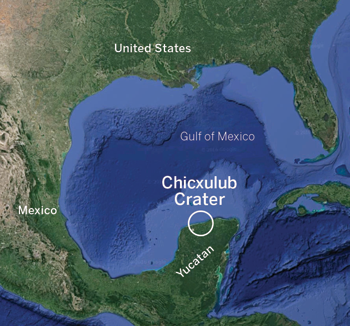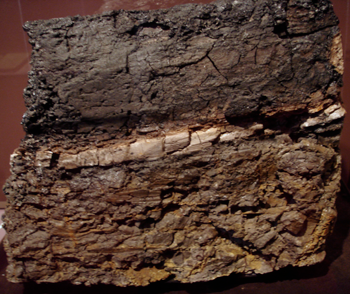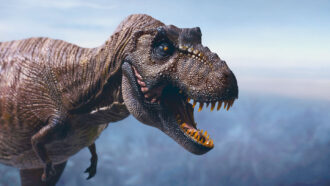What killed the dinosaurs?
New rocky evidence has been emerging about the dinos’ final days

This is an artist’s representation of what may have killed the dinosaurs – although he took some license in representing species that were not all alive at the same time.
Claus Lunau/Science Source
Below the turquoise waters of Mexico’s Yucatán Peninsula lies the site of a long ago mass murder. In a geologic instant, most of the world’s animal and plant species went extinct. Drilling through hundreds of meters of rock, investigators have finally reached the “footprint” left by the accused. That footprint marks Earth’s most notorious space rock impact.
Known as Chicxulub (CHEEK-shuh-loob), it’s the dinosaur killer.

Scientists are assembling the most detailed timeline yet of the dino apocalypse. They are giving fresh scrutiny to telltale fingerprints left by the fateful event so long ago. At the impact site, an asteroid (or maybe a comet) crashed onto Earth’s surface. Mountains formed in mere minutes. In North America, a towering tsunami buried plants and animals alike under thick piles of rubble. Lofted debris darkened skies around the world. The planet chilled — and stayed that way for years.
But the asteroid may not have acted alone.
Life may already have been in trouble. Growing evidence points to a supervolcanic accomplice. Eruptions in what is now India spewed out molten rock and caustic gases. These may have acidified the oceans. All of this could have destabilized ecosystems long before and after the asteroid hit. The jolt of that impact may even have boosted the eruptions, some researchers now argue.
As more clues have emerged, some seem to conflict. That has made the identity of the dinosaurs’ true killer — an impact, volcanism or both — less clear, says Paul Renne. He is a geoscientist at the Berkeley Geochronology Center in California.
“As we’ve improved our understanding of the timing, we haven’t resolved the details,” he says. “The last decade of work has only made it harder to distinguish between the two potential causes.”
The smoking gun
What is clear is that a massive die-off took place around 66 million years ago. It is visible in the layers of rock that mark the boundary between the Cretaceous and Paleogene periods. Fossils that were once abundant no longer appear in rocks after that time. Studies of fossils found (or not found) across the boundary between these two periods — abbreviated the K-Pg boundary — show that some three out of every four plant and animal species went extinct at about the same time. This included everything from the ferocious Tyrannosaurus rex to microscopic plankton.
Everything living on Earth today traces its ancestry to the few lucky survivors.

Over the years, scientists have blamed many suspects for this catastrophic die-out. Some have suggested global plagues struck. Or maybe a supernova fried the planet. In 1980, a team of researchers including father-son duo Luis and Walter Alvarez reported discovering lots of iridium in places worldwide. That element appeared along the K-Pg boundary.
Iridium is rare in Earth’s crust, but abundant in asteroids and other space rocks. The finding marked the first hard evidence for a killer-asteroid impact. But without a crater, the hypothesis couldn’t be confirmed.
Piles of impact debris led crater hunters to the Caribbean. Eleven years after the Alvarez paper, scientists at last identified the smoking gun — the hidden crater.
It circled the coastal Mexican town of Chicxulub Puerto. (The crater actually had been discovered in the late 1970s by oil company scientists. They had used variations in Earth’s gravity to visualize the crater’s 180-kilometer- [110-mile-] wide outline. Word of that find, however, did not reach crater hunters for years.) Based in part on the gaping size of the depression, scientists estimated the size of the impact. They figured it must have released 10 billion times as much energy as the nuclear bomb dropped on Hiroshima, Japan, in 1945.
That’s big.
Questions have remained, though, about how the impact might have caused so much death and destruction worldwide.
It now appears that the blast itself wasn’t the big killer in the impact scenario. It was the darkness that followed.
Inescapable night
The ground shook. Powerful gusts roiled the atmosphere. Debris rained from the sky. Soot and dust, spewed by the impact and resulting wildfires, filled the sky. That soot and dust then began to spread like a giant sunlight-blocking shade over the entire planet.
How long did the darkness last? Some scientists had estimated that it was anywhere from a few months to years. But a new computer model is giving researchers a better sense of what happened.
It simulated the length and severity of the global cooldown. And it must have been truly dramatic, reports Clay Tabor. He works at the National Center for Atmospheric Research in Boulder, Colo. As a paleoclimatologist, he studies ancient climates. And he and his colleagues have reconstructed a sort of digital crime scene. It was one of the most detailed computer simulations ever made of the impact’s effect on climate.
The simulation begins by estimating the climate before the smash-up. The researchers determined what that climate might be from geologic evidence of ancient plants and levels of atmospheric carbon dioxide. Then comes the soot. A high-end estimate of soot totals some 70 billion metric tons (about 77 billion U.S. short tons). That number is based on the size and global fallout of the impact. And it’s huge. It’s the equivalent weight of about 211,000 Empire State Buildings!
For two years, no light reached Earth’s surface, the simulation shows. Not any part of Earth’s surface! Global temperatures plummeted 16 degrees Celsius (30 degrees Fahrenheit). Arctic ice spread southward. Tabor shared this dramatic scenario in September 2016 in Denver, Colo. at the annual meeting of the Geological Society of America.
Some areas would have been hit particularly hard, Tabor’s work suggests. The temperature nosedived in the Pacific Ocean, around the equator. Meanwhile, coastal Antarctica barely cooled. Inland areas generally fared worse than coastal ones. Those divides could help explain why some species and ecosystems weathered the impact while others died off, Tabor says.
Six years after the impact, sunshine returned to levels typical of conditions before the impact. Two years after that, land temperatures warmed to levels higher than had been typical before the impact. Then, all of the carbon flung into the air by the impact took effect. It acted like an insulating blanket over the planet. And the globe ultimately warmed several degrees more.
Evidence of the chilling darkness is in the rock record. Local sea surface temperatures modified lipid (fat) molecules in the membranes of ancient microbes. The fossilized remains of those lipids provide a temperature record, reports Johan Vellekoop. He is a geologist at the University of Leuven in Belgium. Fossilized lipids in what is now New Jersey suggest that temperatures there plummeted 3 degrees C (about 5 degrees F) following the impact. Vellekoop and colleagues shared their estimates in the June 2016 Geology.
Similar abrupt temperature drops plus darkened skies killed plants and other species that nourish the rest of the food web, Vellekoop says. “Dim the lights and the entire ecosystem collapses.”
The cold darkness was the impact’s deadliest weapon. Some unfortunate critters, though, died too soon to witness it.
Story continues below image.

Buried alive
An ancient graveyard covers swaths of Montana, Wyoming and the Dakotas. It’s called the Hell Creek Formation. And it’s hundreds of square kilometers (square miles) of a fossil hunter’s paradise. Erosion has uncovered dinosaur bones. Some jut out of the ground, ready to be plucked and studied.
Robert DePalma is a paleontologist with the Palm Beach Museum of Natural History in Florida. He’s worked in the dry Hell Creek badlands, thousands of kilometers (miles) away from the Chicxulub crater. And there he has found something surprising — signs of a tsunami.
Evidence of the supersized tsunami generated by the Chicxulub impact had previously been found only around the Gulf of Mexico. It had never been seen this far north or so far inland. But the symptoms of tsunami devastation were clear, DePalma says. The rushing water dumped sediment onto the landscape. The debris originated from the nearby Western Interior Seaway. This body of water once cut across North America from Texas to the Arctic Ocean.
The sediment contained iridium and glassy debris that formed from rock vaporized by the impact. It also contained fossils of sea species such as snaillike ammonites. They had been carried from the seaway.
And the evidence didn’t stop there.
At the geological society meeting last year, DePalma pulled up slides of fish fossils found inside the tsunami deposits. “These are the dead bodies,” he said. “If a [crime scene investigation] team walks over to a burnt-out building, how do they know if the guy died before or during the fire? You look for carbon and soot in the lungs. In this case, fish have gills, so we checked those out.”
The gills were packed with glass from the impact. That means the fish were alive and swimming when the asteroid hit. The fish had been alive up until the moment the tsunami pushed across the landscape. It crushed the fish under debris. Those unfortunate fish, DePalma says, are the first known direct victims of the Chicxulub impact.

The climate change and deforestation that followed took longer to do their damage.
Just under the fish-filled tsunami deposits was another amazing find: dinosaur tracks from two species. Jan Smit is an Earth scientist at VU University Amsterdam in the Netherlands. “These dinosaurs were running and alive before they were hit by the tsunami,” he says. “The entire ecosystem in Hell Creek was alive and kicking until the last moment. In no way was it on the decline.”
The new evidence from the Hell Creek Formation confirms that most of the deaths at the time were caused by the Chicxulub impact, Smit now argues. “I was 99 percent sure that it was the impact. And now that we’ve found this evidence, I’m 99.5 percent sure.”
While many other scientists share Smit’s certainty, a growing faction does not. Emerging evidence supports an alternative hypothesis for the dinosaurs’ demise. Their downfall may have come at least partly from deep within the Earth.
Death from below
Long before the Chicxulub impact, a different disaster was underway on the other side of the planet. Back then, India was its own landmass near Madagascar (off of the East Coast of what is now Africa). The Deccan volcanic eruptions there would ultimately belch out some 1.3 million cubic kilometers (300,000 cubic miles) of molten rock and debris. That’s more than enough material to bury Alaska to the height of the world’s tallest skyscraper. Gases spewed by similar volcanic outpourings have been linked to other major extinction events.

Researchers determined the ages of crystals embedded in the Deccan lava flows. These show that most of the eruptions began roughly 250,000 years before the Chicxulub impact. And they continued until about 500,000 years after it. This means that the eruptions were raging at the height of the extinctions.
This new timeline lends credence to those who doubt that the Chicxulub impact was the chief cause of the extinction event.
“Deccan volcanism is vastly more dangerous to life on Earth than an impact,” says Gerta Keller. She is a paleontologist at Princeton University in New Jersey. Recent research is showing just how detrimental. In the same way that iridium marks fallout from the Chicxulub impact, the Deccan volcanism has a calling card of its own. It is the element mercury.
Most mercury in the environment originated from volcanoes. Large eruptions cough up tons of the element. Deccan was no exception. The bulk of the Deccan eruptions released a total of between 99 million and 178 million metric tons (about 109 million and 196 million U.S. short tons) of mercury. Chicxulub released just a fraction of that.
All that mercury left a mark. It shows up in southwestern France and elsewhere. A research team discovered lots of mercury, for instance, in sediment laid down before the impact. Those same sediments held another clue as well — the fossilized shells of plankton (small floating sea organisms) from the dinosaur days. Unlike healthy shells, these specimens are thin and cracked. The researchers reported this in the February 2016 Geology.
The shell pieces suggest that carbon dioxide released by the Deccan eruptions made the oceans too acidic for some creatures, says Thierry Adatte. He is a geoscientist at the University of Lausanne in Switzerland. He coauthored the study with Keller.
“Survival was getting very difficult for these critters,” Keller says. Plankton form the foundation of the ocean ecosystem. Their decline rattled the entire food web, she suspects. (A similar trend is happening today as seawater soaks up carbon dioxide from the burning of fossil fuels.) And as waters turned more acidic, it took the animals more energy to make their shells.
Partners in crime
The Deccan eruptions wreaked havoc in at least part of Antarctica. Researchers analyzed the chemical makeup of shells from 29 clamlike shellfish species on the continent’s Seymour Island. The shells’ chemicals differ depending on the temperature at the time they were made. That let the researchers assemble a roughly 3.5-million-year record of how Antarctic temperatures changed around the time of the dinosaur extinction.

After the start of the Deccan eruptions and the resulting rise in atmospheric carbon dioxide, local temperatures warmed about 7.8 degrees C (14 degrees F). The team reported these results in the July 2016 Nature Communications.
About 150,000 years later, a second, smaller warming phase coincided with the Chicxulub impact. Both of these warming periods corresponded with high extinction rates on the island.
“Everyone wasn’t just living happily, and then boom, this impact came out of nowhere,” says Sierra Petersen. She is a geochemist at the University of Michigan in Ann Arbor. She also worked on this study. Plants and animals “were already under stress and not having a great day. And this impact happens and pushes them over the top,” she says.
Both catastrophic events were major contributors to the extinctions. “Either one would have caused some extinction,” she says. “But such a mass extinction is due to a combination of both events,” she now concludes.
Not everyone agrees.
Noting that some parts of the world were affected by the Deccan eruptions before the impact is not enough to show that life overall was stressed back then, says Joanna Morgan. She is a geophysicist at Imperial College London in England. Fossil evidence in many areas, she says, suggests that sea life flourished until the impact.
But maybe bad luck wasn’t the reason the dinosaurs encountered two devastating disasters at once. Maybe the impact and the volcanism were related, some researchers propose. The idea isn’t an attempt to get impact purists and the volcano devotees to play nice. Volcanoes often erupt after major earthquakes. This happened in 1960. The Cordón-Caulle eruption in Chile started two days after a nearby magnitude-9.5 quake. The seismic shock waves from the Chicxulub impact potentially reached even higher — a magnitude 10 or more, Renne says.
He and his colleagues have traced the intensity of the volcanism during the time of the impact. Eruptions before and after it went on uninterrupted for 91,000 years. Renne reported that last April at a meeting in Vienna, Austria of the European Geosciences Union. The nature of the eruptions, however, changed within 50,000 years before or after the impact. The amount of erupted material jumped from 0.2 to 0.6 cubic kilometer (0.05 to 0.14 cubic mile) annually. Something must have altered the volcanic plumbing, he says.
In 2015, Renne and his team formally outlined their one-two punch extinction hypothesis in Science. The shock of the impact fractured the rock enclosing the Deccan magma, they proposed. That allowed the molten rock to expand and possibly enlarge or combine magma chambers. Dissolved gases in the magma formed bubbles. Those bubbles propelled material upward like in a shaken soda can.
The physics behind this impact-volcano combo is not firm, say scientists on both sides of the debate. That’s true especially because Deccan and the impact site were so distant from each other. “This is all guesswork and perhaps wishful thinking,” Princeton’s Keller says.
Sean Gulick also isn’t convinced. He says the evidence isn’t there. He is a geophysicist at the University of Texas at Austin. “They’re hunting for another explanation when there’s already an obvious one,” he says. “The impact did it alone.”
Over the coming months and years, improved computer simulations of the dinosaur doomsday — and ongoing studies of Chicxulub and Deccan rocks — could further shake up the debate. For now, a definitive guilty verdict on either accused killer would be difficult, Renne predicts.
Both events devastated the planet in similar ways at around the same time. “It’s no longer easy to distinguish between the two,” he says. For now, at least, the case of the dinosaur killer will remain an unsolved mystery.







